Salve Archives & Special Collections
Exhibits

Curated by Caroline Fenstermacher, '26
In 1974, Monumenta, a group of Princeton art history scholars and Middletown and Newport community members, organized a public sculpture exhibition throughout the city of Newport. The organizers named the exhibition Sculpture in Environment, but it was commonly referred to as Monumenta. Designed to extend the Newport summer tourist season, the exhibition ran from August 17 to October 13, 1974. The broad exhibit featured 53 monumental sculptures and earthworks created by artists around the world, drawing criticism and praise from local critics and renowned publications alike. Though poorly received by a public audience not interested in Modern art, Monumenta created a rare opportunity to see a large, comprehensive, international sculpture show with a variety of prestigious 20th century sculptors completely free of charge.
This year celebrates the 50th anniversary of Monumenta’s visionary monumental public art exhibition.
Monumenta began as an idea to extend the Newport tourist season to offset the negative economic effects after the U.S. Navy Atlantic Fleet withdrew from Newport. As the wealth and glamor of the Gilded Age faded in the early 20th century, the Newport economy relied on the revenue generated by its active Navy base. The Navy’s departure left Newport struggling, outdated, and seemingly stuck in the 19th century. William Crimmins, an active philanthropist and Middletown community member, suggested the idea of hosting a public sculpture exhibition throughout the city to bolster Newport’s floundering economy. Crimmins envisioned Monumenta as an opportunity to enhance Newport’s reputation as a tourist town and to bring the city into the 20th century. Partnering with local art enthusiasts and Princeton University art history scholars, Crimmins served as the President of Monumenta.
The Monumenta organization formed Monumenta, Inc. with an office located on Spring Street in Newport. The officers included President Crimmins, Vice President Gail Baker, Treasurer Marion Nelson, Secretary Suzette Schochet, and Assistant Secretary Arthur Murphy. Gail Baker was a local artist who also lectured for the Art Association of Newport, and Marion Nelson served on the Newport County Arts Council. Suzette Schochet was the wife of Jay Schochet, an urban developer and philanthropist who had recently developed the Brick Market Place. Crimmins collaborated with Schochet to use the Brick Market Place as a sculpture site in an effort to promote both the stores recently installed at Brick Market Place and the exhibition.
The Monumenta Exhibition Staff consisted of Princeton art history scholars and curators working with the Monumenta officers to compile the entire exhibit within a year and a half. Princeton University art history professor Sam Hunter served as the Director of Monumenta, and two of his graduate students, Sally Yard and Eileen Guggenheim, were credited as Research Assistants in the exhibition catalogue Monumenta: A Biennial Exhibition of Outdoor Sculpture. Sally Yard wrote several essays about Monumenta for various art publications. She also conducted an interview with Bulgarian environmental artist, Christo, and wrote an essay about his involvement in Monumenta for the publication Christo|Ocean Front. Curator Nancy Rosen, a graduate from Goucher College in Maryland, managed the bulk of paperwork and communications between lenders, insurance and shipping companies, the Preservation Society of Newport County, and Monumenta, Inc. Assistant Director Hugh Davies aided Rosen and Hunter’s responsibilities with paperwork and coordinated the installation process for all of the sculptures.
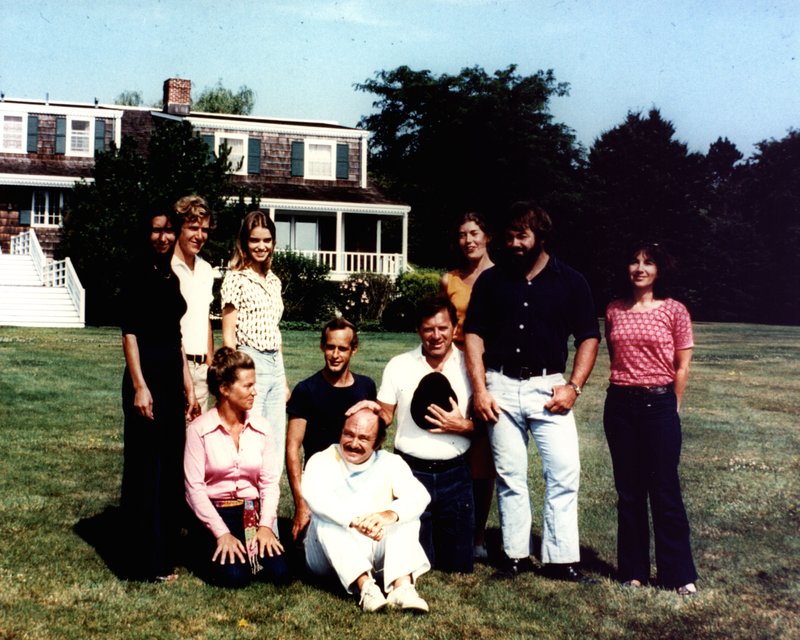
(Standing, left to right) Sally Yard, Hugh Davies, Daisy Davidson, Nancy Rosen, Isaac Witkin, Thelma Appel
(Sitting and kneeling, left to right) Gael Crimmins, Peter Scholl (black shirt), Sam Hunter, William Crimmins
Isaac Witkin assisted with the installation of his sculpture, Alnasco. Thelma Appel, the wife of Karel Appel, assisted with the installation of her husband’s work, Man with Flowers. Gael Crimmins is the wife of William Crimmins. Peter Scholl was an old friend of Hugh Davies who was integral to the installation of the sculptures.
Monumenta Officers
President William A. Crimmins
Vice President Gail Baker
Treasurer Marion Nelson
Secretary Suzette Schochet
Assistant Secretary Arthur Murphy
Exhibition Staff
Director Sam Hunter
Assistant Director Hugh M. Davies
Curator Nancy D. Rosen
Research Assistants Sally E. Yard and Eileen Guggenheim
The nature of Monumenta– to exhibit monumental sculptures– provided many logistical obstacles for Monumenta, Inc. Shipping, insurance, security, constructing foundations on-site, and the manpower needed to install such large sculptures created challenges unique to a public sculpture show with the scope and breadth of Monumenta.
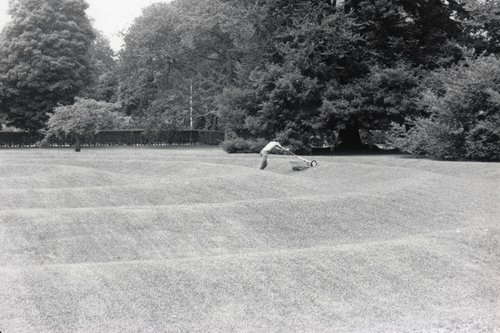
Worker mowing Richard Fleischner’s Sod Maze, an earthwork still visible today at Chateau-sur-Mer
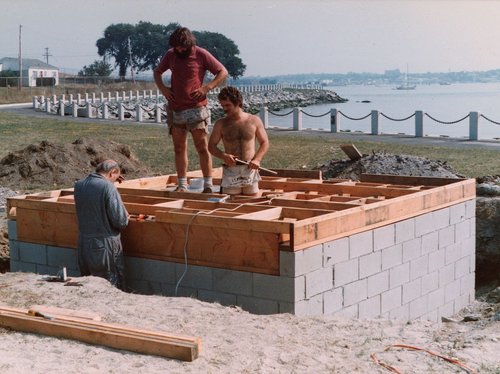
Workers creating a foundation at Fort Adams
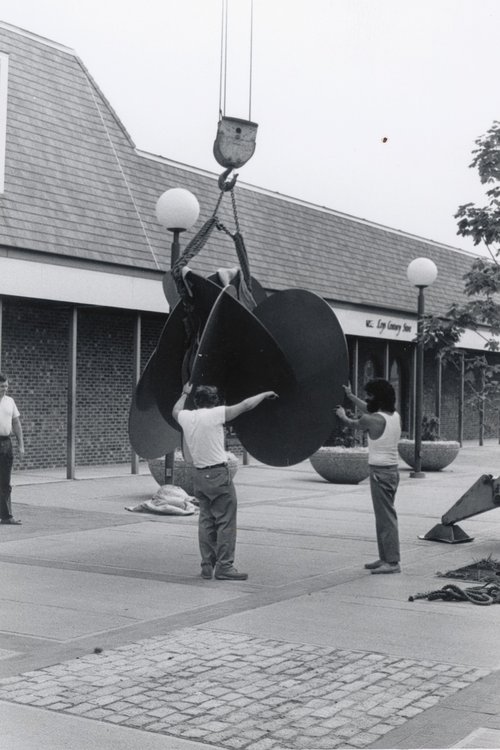
Installing Tony Rosenthal’s Odyssey at the Brick Market Place

Installing Claes Oldenburg’s Geometric Mouse at Brenton State Park along Ocean Drive
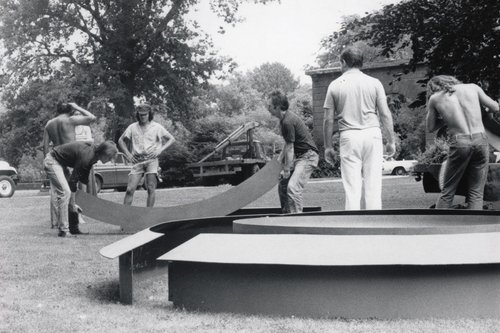
Installing Jules Olitski’s Chinese Cassandra at Chateau-sur-Mer

Using a crane to install Alexander Liberman’s Argo near King’s Cove along Ocean Drive
Monumenta opened with a symposium held at the Rosecliff mansion on Bellevue Avenue Friday night, August 16, 1974. Three sculptors in the show, Louise Nevelson, George Rickey, and Robert Grosevnor; Hilton Kramer, an art critic from the New York Times; and Peter Blake, the editor of the Architecture Plus magazine, attended the symposium along with Monumenta organizers. Monumenta organizers intended for the symposium to be a panel discussion hosted by Monumenta Director Sam Hunter to encourage conversation about Modern art and its place in public life as well as sculpture in relation to its environment. Kramer incited heavily opinionated discussion between artists, Monumenta organizers, and attendees alike at the symposium with his pointed observations and discussion questions. Despite some awkward discussion, including both the exchange of deeply-held beliefs and the logistical task of sharing a single microphone, the symposium succeeded in encouraging conversation about Modern art between artists and attendees.
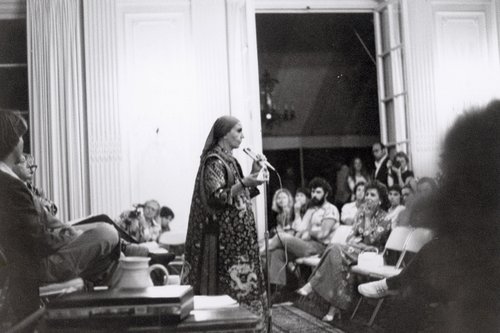
Louise Nevelson speaking at the symposium at Rosecliff on Friday, August 16, 1974
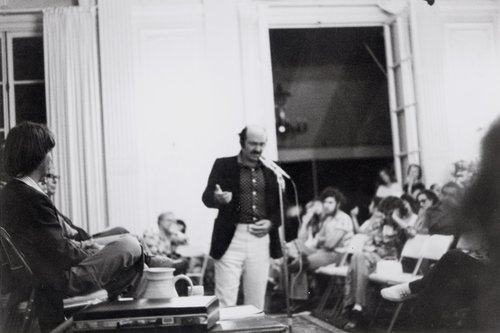
Sam Hunter speaking at the symposium
Monumenta inspired harsh reactions within the traditional, predominantly 19th century-style town of Newport. Many local citizens were annoyed by the seeming “clutter” of the monumental public sculptures. Citizens of Newport maintained that their town was known best for its impressive Gilded Age architecture, not displays of 20th century sculpture. Unaware of the show, tourists approached and interacted with the sculptures in wonder, curiosity, and amusement. Despite tough criticism, several members of the community acknowledged and admired Monumenta’s artistic, cultural, and economic significance.

Two women reclining in Lila Katzen’s Oracle installed at Bleak House Point along Ocean Drive
Several of the sculptures in Monumenta were subject to vandalism. Although security officers guarded sculptures displayed on the Newport Preservation Society grounds, sculptures installed along Ocean Drive were left susceptible to vandalism.
Alexander Liberman’s Argo was repeatedly spray painted. The graffiti was painted over several times with white Swedish car paint.
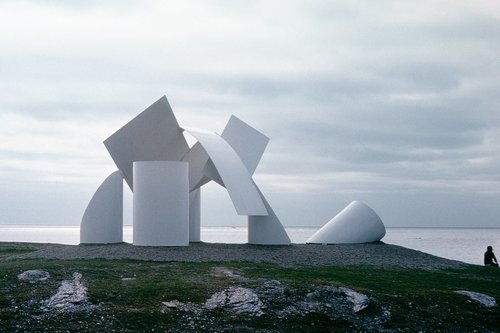
Alexander Liberman’s Argo displayed along Ocean Drive near King’s Cove
A section of Anne Healy’s Hot Lips was stolen by a student at St. George’s School. Monumenta President William Crimmins managed to track down the car that reportedly stole the sculpture to the school where it was found hanging from the ceiling of the student’s dormitory.
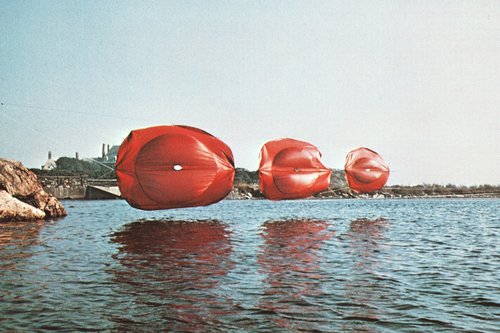
Anne Healy’s Hot Lips suspended above Goose Neck Pond along Ocean Drive
A few juvenile boys pushed Clement Meadmore’s Around and About over the edge of a cliff near Brenton State Park on August 8, 1974. The sculpture was installed earlier that day, but it was not properly anchored into place.
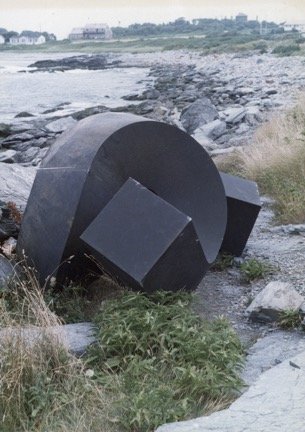
Around and About at the bottom of a cliff along Ocean Drive

Crane lifting Around and About
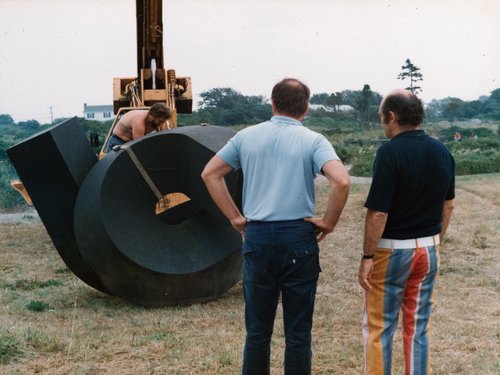
Monumenta President William Crimmins (left) and Director Sam Hunter (right)
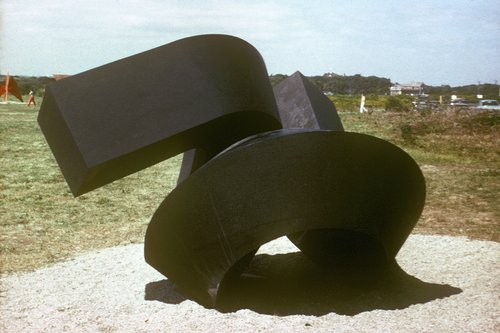
Around and About installed along Ocean Drive at Bleak House
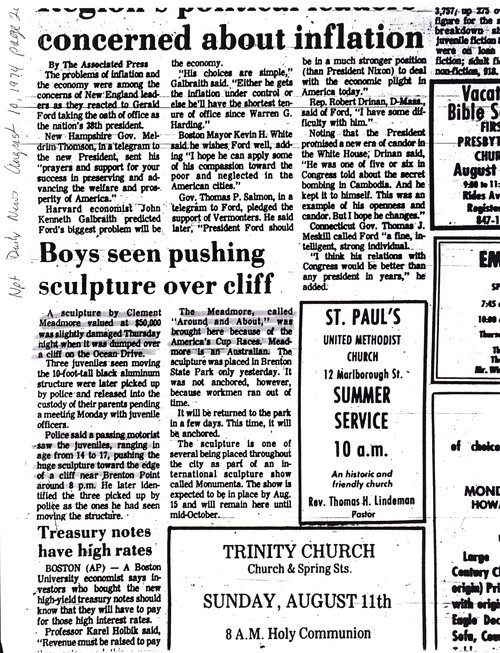
Article from Newport Daily News from August 10, 1974 reporting the incident
David Smith (1906-1965)
David Smith was one of the most influential American sculptors of the 20th century included in the Monumenta exhibit. The Monumenta organizers chose to install his work from the early 1960s on the grounds of the Elms Mansion, the property of the Preservation Society of Newport County. Smith created his sculptures by welding scraps of metal together to create sculptures that sprang directly from his consciousness, in true Surrealist fashion. Smith’s works in Monumenta showcased his lasting impact on Minimalist art of the 1960s that was rooted in the Expressionism, Surrealism, and Cubism of the early 20th century.
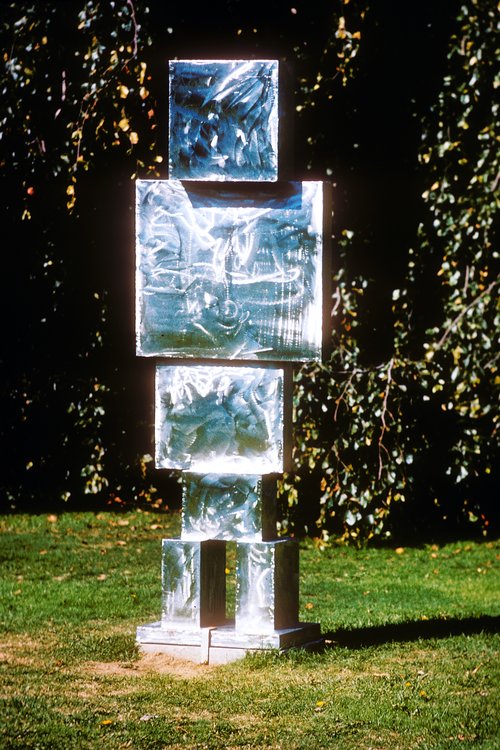
Cubi III, 1961
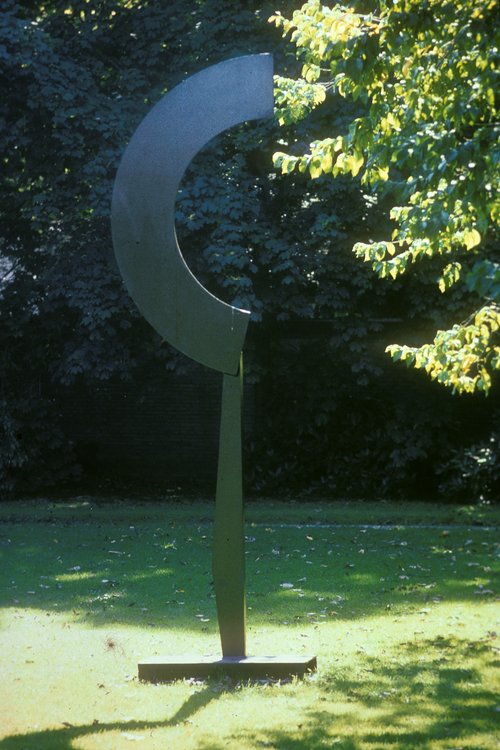
Lunar Arc, 1961
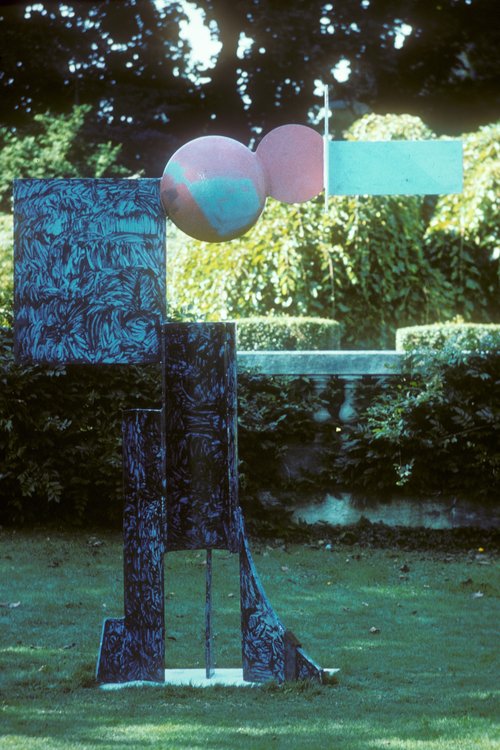
Zig V, 1961

Primo Plano III, 1962
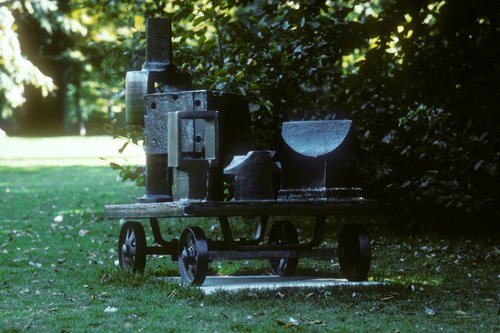
Voltri XVIII, 1962
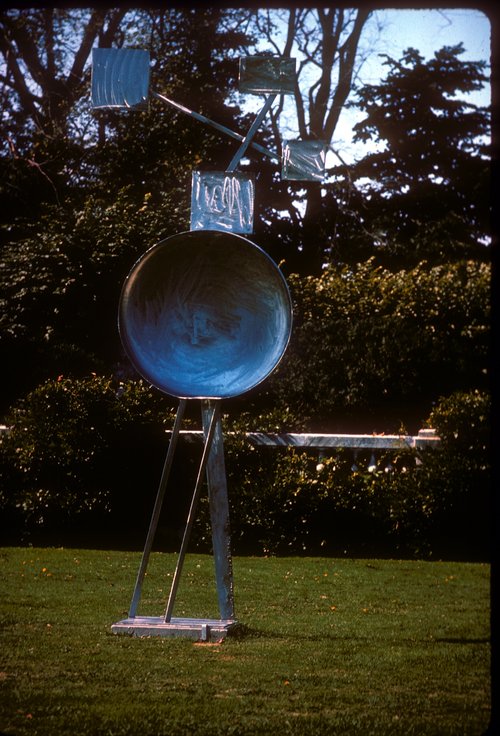
Windtotem, 1962
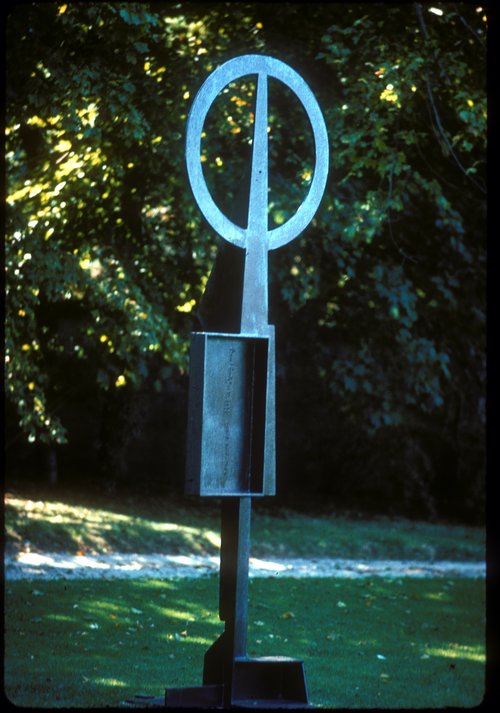
Circle and Box, 1963
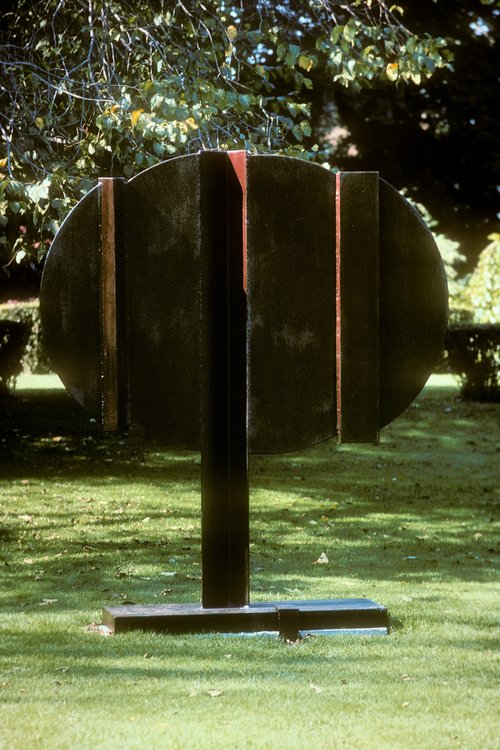
Oval Node I, 1963
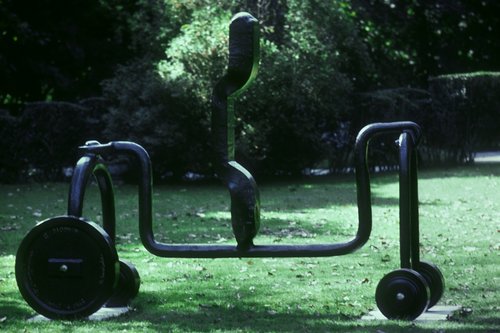
Wagon II, 1964
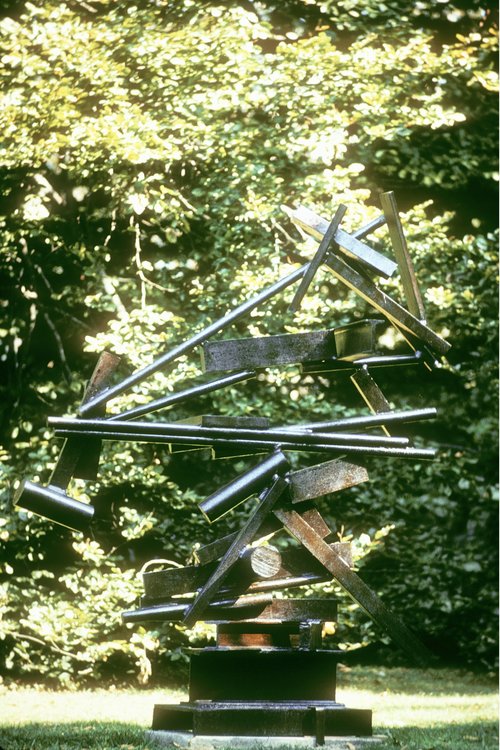
Untitled, c. 1960
Barnett Newman (1905-1970)
Barnett Newman’s work was displayed alongside David Smith’s work on the grounds of the Elms. Before Newman began his career as an artist, he studied philosophy and ventured into New York City politics on a base of support for social and civic programs promoting the arts. Newman realized his iconic “zip” in 1948 with his painting Onement I. The painting featured a single vertical form on a painted canvas. Newman represented these “zips” in three-dimensional form with the Here sculpture series that he created in the 1960s. Monumenta featured Newman’s Here series as well as Zim Zum, a sculpture evoking the same vertical elements as his free standing “zips.”

Here I (to Marcia), 1950
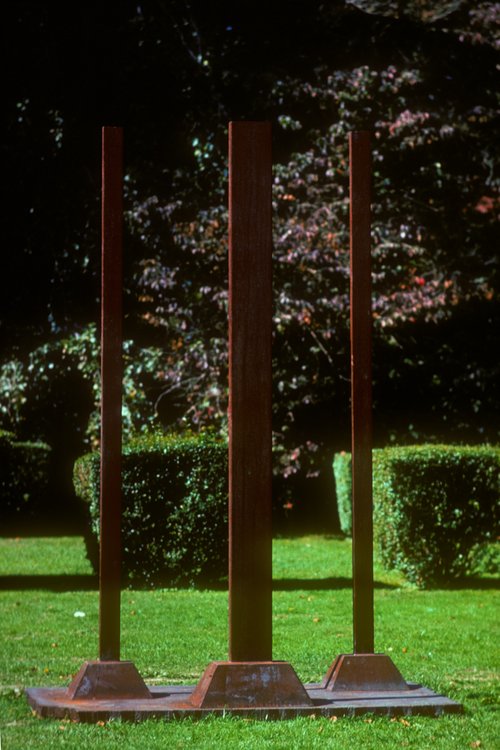
Here II, 1965
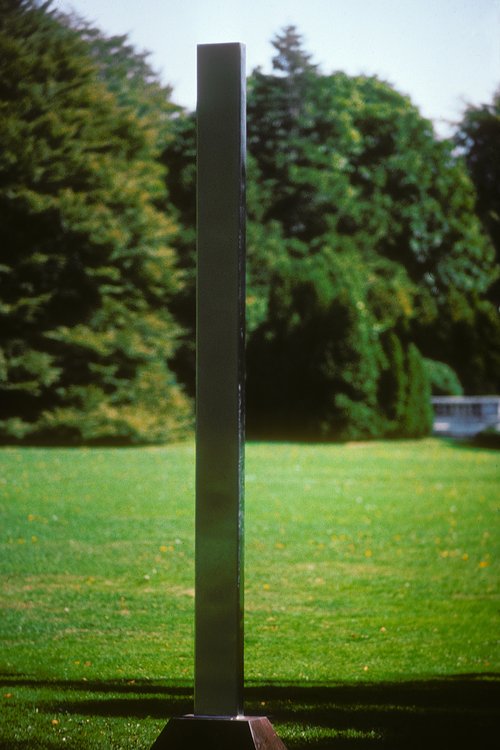
Here III, 1966

Zim Zum, 1969
Willem de Kooning (1904-1997)
Willem de Kooning created work in the Abstract Expressionist style popular in early to mid-20th century New York City. Trained in fine and commercial arts in his native city of Rotterdam in the Netherlands, de Kooning emigrated to the United States in the late 1920s where he worked as a house painter. Inspired by lyrical, expressive jazz music as well as Abstract Expressionists and Surrealists like Joan Miró, Pablo Picasso, Arshile Gorky, and John Graham, de Kooning often merged abstraction with figurative forms. His preoccupation with the violent, abstract representation of the female figure is a common theme throughout his career. de Kooning made a brief foray into sculpture in the late 1960s to early 1970s, bringing his abstract expressionist figures into the third dimension. He created several bronze Clam Digger sculptures— one of which Monumenta displayed on the grounds of Chateau-sur-Mer. Monumenta provided the rare opportunity to view de Kooning as a sculptor rather than a painter.

Clam Digger, 1972
Christo (1935-2020)
Christo was an environmental sculptor known for creating large artworks that consisted of wrapping or covering buildings, objects, or natural forms. Trained in Socialist Realism in Soviet Bulgaria, Christo fled to Paris where he met Jeanne-Claude, his wife and artistic partner. After creating monumental, temporary sculptures and wrapping public buildings across Europe, Christo and Jeanne-Claude emigrated to New York in 1964. Ten years later, William Crimmins, President of Monumenta, invited Christo to create an original work for Monumenta, resulting in Ocean Front Project. The project involved covering the water at King’s Beach with 150,000 square yards of white woven polypropylene fabric so that the waves created a constant, rippling effect beneath the surface of the fabric. This sculpture truly reflected Monumenta’s examination of sculpture in relation to the environment because the ocean waves played an integral role in Christo's project.
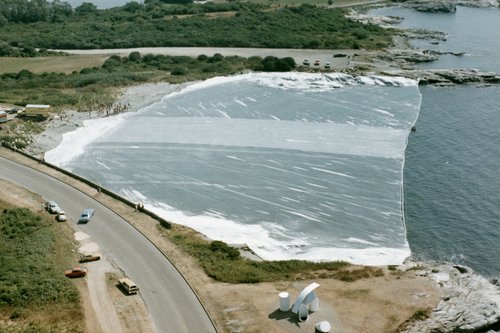
Ocean Front, Newport August 1974
Christo’s Ocean Front was unique from other sculptures in Monumenta because of the collaborative and performative characteristics of its installation and its temporary nature. Under the direction of Christo, 40 young volunteers, mostly college art students, began assembling the 150,000 square yards of white woven polypropylene fabric at 6 am on Monday, August 19. By 4 pm, the volunteers successfully anchored the fabric to the beach at King’s Cove and were paid $20 for their help. The project lasted for 8 days before it was dismantled, and the beach was promptly returned to its natural state. The collaboration of multiple entities, from the artist to the people involved with the physical installation of the work, were acts of performance that contributed to the end result of Christo’s project.
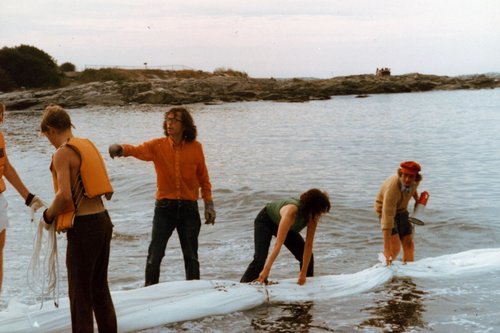
Christo (in orange) directing volunteers
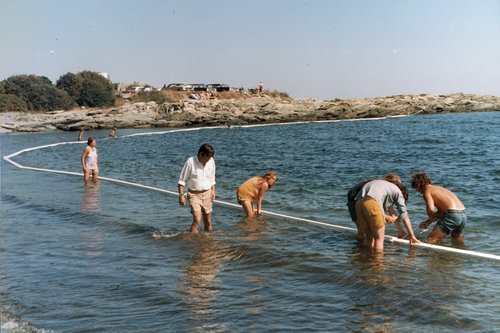
Volunteers in water
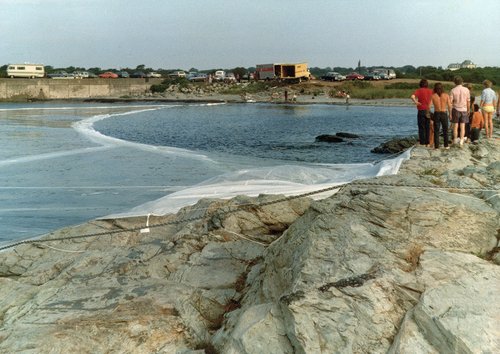
Volunteers on rocks of King’s Cove looking at polypropylene fabric in water
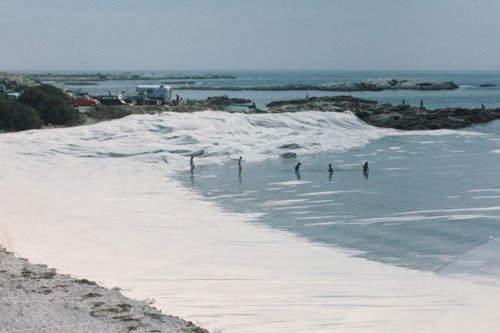
Volunteers walking on top of polypropylene fabric in King’s Cove
Henry Moore (1898-1986)
Henry Moore, a British artist, was best known for his solid, harmonious sculptures of reclining figures that blended the figurative with the abstract and surreal. Moore sought direct inspiration from non-Western art, particularly from ancient Mexican sculptures, in opposition to his more academic instruction that he received at the Leeds School of Art and the Royal Academy in London. Moore served in the British Army in World War I, and he was appointed as a government artist during World War II for his moving drawings of British citizens during the bombing of London. His post-war modern sculptures resonated with the public for their stability, harmony, and comfortable scenes of family life. Moore’s Two Piece Reclining Figure No. 9 is a prime example of his stable, harmonious sculptures that combine the figurative with the abstract. As one of the most influential sculptors of the 20th century, it was fitting to include one of Moore’s works among that of his contemporaries and admirers in the Monumenta exhibit.
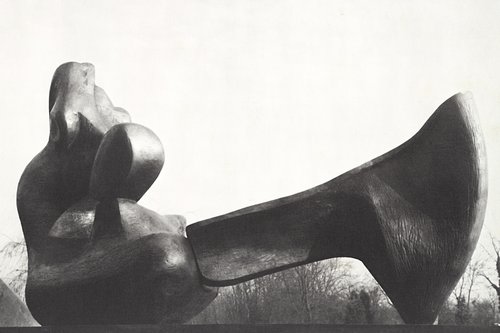
Two Piece Reclining Figure No. 9, 1967
Barbara Hepworth (1903-1975)
Barbara Hepworth was one among several influential British sculptors of the mid-20th century. Educated at the Leeds School of Art– where she befriended fellow sculptor Henry Moore– and the Royal College of Art in London, Hepworth’s work exhibited a naturalism inspired by the different environments she found herself absorbed in. Throughout her life she sought inspiration from the scenery of her home in Wakefield, England and her travels to Italy and Greece. After giving birth to triplets in 1933, her work became more formal with an intense examination of form, mass, space, and flow. By the late 1940s, she shifted back towards a more naturalist examination of space and form. Her later works involved carving holes into her sculptures, like River Form 1963 displayed on the ground of Chateau-sur-Mer during Monumenta. In March 1975, Hepworth died in a fire at her studio in Cornwall, but her legacy remains as a highly esteemed British 20th century sculptor.
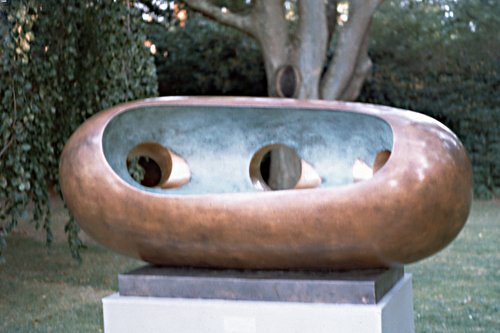
River Form 1963, 1973
Lippincott, Inc. in North Haven, Connecticut, served as one of the only metal fabrication workshops functioning solely for creating monumental art in the United States in the 20th century. Several artists in the Monumenta show had their work fabricated or repaired at Lippincott, including Barnett Newman, Louise Nevelson, Robert Indiana, Alexander Calder, and Clement Meadmore among others. The fabricators at Lippincott functioned as the artist’s hands, catering specifically to each artist’s unique needs. Although the North Haven factory closed in 1994, Lippincott, LLC continues to create and conserve monumental sculpture.
Karel Appel
Man with Flower, 1971
William King
The Truth, 1970
Tony Rosenthal
Odyssey, 1974
Alexander Calder
Lightening, 1970
Lyman Kipp
Hudson Bay, 1968
Lucas Samaras
Stiff Box #15, 1971
Anthony Caro
Vespers, 1974
John Chamberlain
Viper’s Bugloss, 1973
Christo
Ocean Front Project for Covering the Cove at King’s Beach, 1974
Willem De Kooning
Clam Digger, 1972
George Kuehn
Untitled, 1972
Alexander Liberman
Argo, 1974
Clement Meadmore
Around and About, 1971
Henry Moore
Two Piece Reclining Figure No. 9, 1967
David Smith
Cubi IIIi, 1961
Lunar Arc, 1961
Zig V, 1961
Primo Plano III, 1962
Voltri XVIII, 1962
Windtotem, 1962
Circle and Box, 1963
Oval Node I, 1963
Wagon II, 1964
Untitled, c. 1960
Kosso Eloul
Gomil, 1971
Robert Murray
Windhover, 1969
Tony Smith
Amaryllis, 1965
Herbert Ferber
Morgan II, 1971
Louise Nevelson
Night Tree, 1971
George Sugarman
Kite Castle, 1974
Richard Fleischner
Sod Maze, 1974
Peter Gourfain
Untitled, 1973
Barnett Newman
Here I (to Marcia), 1950
Here II, 1965
Here III, 1966
Zim Zum, 1969
Hugh Townley
Treehouse Dream, 1974
Robert Grosevnor
Untitled, 1974
Claes Oldenburg
Geometric Mouse, Scale X, 1971
Paul von Ringelheim
Perimeter, 1973
Brower Hatcher
Zic Zac, 1974
Jules Olitski
Chinese Cassandra, 1973
Isaac Witkin
Alnasco, 1974
Anne Healy
Cathedral, 1974
Hot Lips, 1970
Arnaldo Pomodoro
Collapsed Movement, 1970-71
James Wolfe
Sway, 1974
Barbara Hepworth
River Form (1965), 1973
George Rickey
Four Lines Oblique Gyratory–Rhombus, 1972
Robert Indiana
Art, 1972
Salvatore Romano
45 Parallel, 1974
Lila Katzen
Oracle, 1974
James Rosati
Untitled, 1963-70
Crimmins, William. "Interview with William Crimmins," by Diane Petrella. 29 Novemeber 2005.
"History." Lippincott Sculpture, www.lippincottsculpture.com/history. Accessed 8 July 2024.
Hugh Marlais Davies papers, 1974. Archives of American Art, Smithsonian Institution.
Petrella, Diane. Monumenta. May 2006. Salve Regina University, Thesis for the Department of Art.